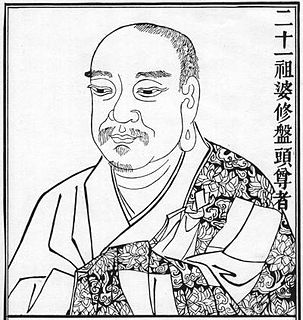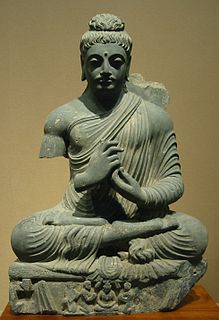
Buddhist philosophy refers to the philosophical investigations and systems of inquiry that developed among various Buddhist schools in India following the parinirvana of the Buddha and later spread throughout Asia. The Buddhist path combines both philosophical reasoning and meditation. The Buddhist traditions present a multitude of Buddhist paths to liberation, and Buddhist thinkers in India and subsequently in East Asia have covered topics as varied as phenomenology, ethics, ontology, epistemology, logic and philosophy of time in their analysis of these paths.

The Sarvāstivāda was one of the early Buddhist schools established around the reign of Asoka. It was particularly known as an Abhidharma tradition, with a unique set of seven Abhidharma works.
Yogachara is an influential tradition of Buddhist philosophy and psychology emphasizing the study of cognition, perception, and consciousness through the interior lens of meditative and yogic practices. It is also variously termed Vijñānavāda, Vijñaptivāda or Vijñaptimātratā-vāda, which is also the name given to its major epistemic theory. There are several interpretations of this main theory, some scholars see it as a kind of Idealism while others argue that it is closer to a kind of phenomenology or representationalism, aimed at deconstructing the reification of our perceptions.

Vasubandhu was an influential Buddhist monk and scholar from Gandhara. He was a philosopher who wrote commentary on the Abhidharma, from the perspectives of the Sarvastivada and Sautrāntika schools. After his conversion to Mahayana Buddhism, along with his half-brother, Asanga, he was also one of the main founders of the Yogacara school. Along with his brother, he is known as one of the seventeen Nalanda masters as he taught at the monastery located in modern-day Bihar.
Rebirth in Buddhism refers to the teaching that the actions of a person lead to a new existence after death, in an endless cycle called saṃsāra. This cycle is considered to be dukkha, unsatisfactory and painful. The cycle stops only if moksha (liberation) is achieved by insight and the extinguishing of craving. Rebirth is one of the foundational doctrines of Buddhism, along with karma, Nirvana and moksha.
The Sautrāntika or Sutravadin were an early Buddhist school generally believed to be descended from the Sthavira nikāya by way of their immediate parent school, the Sarvāstivādins. While they are identified as a unique doctrinal tendency, they were part of the Sarvāstivāda Vinaya lineage of monastic ordination.
The Abhidharmakośabhāsya, Abhidharmakośa for short, is a key text on the Abhidharma written in Sanskrit by the Indian Buddhist scholar Vasubandhu in the 4th or 5th century CE. The Kośa summarizes the Sarvāstivādin Abhidharma in eight chapters with a total of around 600 verses and then comments on it. This text was widely respected and used by schools of Buddhism in India, Tibet and East Asia. Over time, the Abhidharmakośa became the main source of Abhidharma and Sravakayana Buddhism for later Mahāyāna Buddhists.

Dignāga was an Indian Buddhist scholar and one of the Buddhist founders of Indian logic. Dignāga's work laid the groundwork for the development of deductive logic in India and created the first system of Buddhist logic and epistemology (Pramana).

Dharmakīrti, , was an influential Indian Buddhist philosopher who worked at Nālandā. He was one of the key scholars of epistemology (pramāṇa) in Buddhist philosophy, and is associated with the Yogācāra and Sautrāntika schools. He was also one of the primary theorists of Buddhist atomism. His works influenced the scholars of Mīmāṃsā, Nyaya and Shaivism schools of Hindu philosophy as well as scholars of Jainism.
Mindstream (citta-santāna) in Buddhist philosophy is the moment-to-moment continuum of sense impressions and mental phenomena, which is also described as continuing from one life to another.
Sattva is one of the three guṇas or "modes of existence", a philosophical and psychological concept understood by the Samkhya school of Hindu philosophy. The other two qualities are rajas and tamas. Sattva is the quality of goodness, positivity, truth, serenity, balance, peacefulness, and virtuousness that is drawn towards Dharma and Jnana (knowledge).

Śāntarakṣita, whose name translates into English as "protected by the One who is at peace" was an important and influential Indian Buddhist philosopher, particularly for the Tibetan Buddhist tradition. Śāntarakṣita was a philosopher of the Madhyamaka school who studied at Nalanda monastery under Jñānagarbha, and became the founder of Samye, the first Buddhist monastery in Tibet.
Atomism is a natural philosophy proposing that the physical universe is composed of fundamental indivisible components known as atoms.

Buddhist logico-epistemology is a term used in Western scholarship for pramāṇa-vāda and Hetu-vidya. Pramāṇa-vāda is an epistemological study of the nature of knowledge; Hetu-vidya is a system of logic. These models developed in India during the 5th through 7th centuries.

Sarvāstivāda-Vaibhāṣika or simply Vaibhāṣika, refers to an ancient Buddhist tradition of Abhidharma, which was very influential in north India, especially Kashmir. In various texts, they referred to their tradition as Yuktavāda, and another name for them was Hetuvāda. The Vaibhāṣika school was an influential subgroup of the larger Sarvāstivāda school. They were distinguished from other Sarvāstivāda sub-schools like the Sautrāntika and the "Western Masters" of Gandhara and Bactria by their orthodox adherence to the doctrines found in the Mahāvibhāṣa. Vaibhāṣika thought significantly influenced the Buddhist philosophy of all major Mahayana Buddhist schools of thought and also influenced the later forms of Theravāda Abhidhamma.
The Tattvasiddhi-Śāstra, is an Indian Abhidharma Buddhist text by a figure known as Harivarman (250-350).

Abhidharma (Sanskrit) or Abhidhamma (Pali) are ancient Buddhist texts which contain detailed scholastic presentations of doctrinal material appearing in the Buddhist sutras. It also refers to the scholastic method itself as well as the field of knowledge that this method is said to study.
In Buddhist philosophy, Svasaṃvedana is a term which refers to the self-reflexive nature of consciousness. It was initially a theory of cognition held by the Mahasamghika and Sautrantika schools while the Sarvastivada-Vaibhasika school argued against it.
Praśastapāda was an ancient Indian philosopher. He wrote the Padārtha-dharma-saṅgraha and a commentary, titled Praśastapāda Bhāṣya, on the Vaisheshika Sutras of Kanada ; both texts are comprehensive books in physics. In these texts Prashastapada discusses the properties of motion. Ganganath Jha had translated Praśastapāda Bhāṣya which was published in 1916. Prashasta or Praśasta means praised or praiseworthy, lauded or laudable, commended or commendable or eulogized.

The Theravāda Abhidhamma is a scholastic systematization of the Theravāda school's understanding of the highest Buddhist teachings (Abhidhamma). These teachings are traditionally believed to have been taught by the Buddha, though modern scholars date the texts of the Abhidhamma Piṭaka to the 3rd century BCE. Theravāda traditionally sees itself as the vibhajjavāda, which reflects the analytical (vibhajjati) method used by the Buddha and early Buddhists to investigate the nature of the person and other phenomena.








